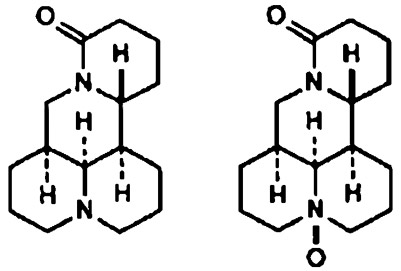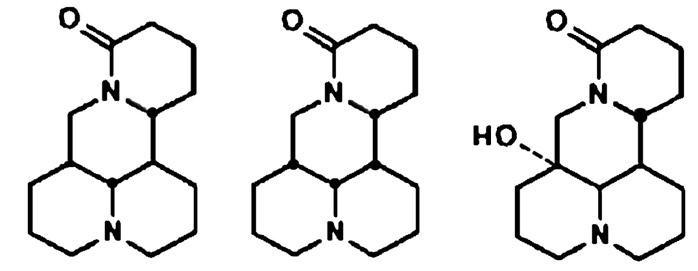
Figure 1: Matrine (left) and oxymatrine (right).

Figure 2: Allomatrine (left), isomatrine (middle) and sophoranol (right).
MATRINE AND OXYMATRINE
Subjects Of Chinese Research
Matrine and oxymatrine are the two major alkaloid components found in sophora roots. They are obtained primarily from Sophora japonica (kushen), but also from Sophora subprostrata (shandougen), and from the above ground portion of Sophora alopecuroides. The matrines were first isolated and identified in 1958; they are unique tetracyclo-quinolizindine alkaloids (see Figure 1) found only in Sophora species thus far. An intensive investigation into the pharmacology and clinical applications of these alkaloids has gone on for the past decade and remains one of the focal points of Chinese medical research. The main clinical applications are treatment of people with cancer, viral hepatitis, cardiac diseases (such as viral myocarditis), and skin diseases (such as psoriasis and eczema).
The crude herb and crude hot-water extracts of sophora have been available in the West for more than 25 years. An alkaloid fraction of sophora roots containing a standardized level of oxymatrine and matrine (20%) was first introduced by the Institute for Traditional Medicine, and made available to practitioners in tablet form under the name Oxymatrine (White Tiger) in 1998. It has been used without reported side effects. In China, the alkaloids are often given by injection, but this method of administration is not acceptable in the West, so oral dosing is used here instead. When taken orally, much of the oxymatrine is converted to matrine; to get high blood levels of oxymatrine, it must be given by injection. However, it is unclear whether oxymatrine is clinically more effective than matrine. Chinese researchers have also used the alkaloids in capsule form, with results that appear similar to the injection. Sophora is also administered in complex formulas made as decoctions and taken orally.
Sophora japonica contains about a dozen alkaloids, with matrine and oxymatrine being by far the highest, together comprising about 2% of the dried root stock (most of it in the form of oxymatrine), followed by closely related alkaloids: mainly sophocarpine, but also minute amounts of sophoranol, sophoramine, sophoridine, allomatrine, isomatrine, and others (see Figure 2). These alkaloids were first reported as constituents of kushen in a series of publications from 1958-1978.
An overview of recent research on the pharmacology and clinical applications of the sophora alkaloids is presented below. In general, the dosage of the sophora alkaloids administered clinically is in the range of 400-600 mg per day.
As described by Chen Yanxi and his colleagues at the Shanghai Second Medical University (1):
In recent years, oxymatrine has been recommended for treating chronic hepatitis B and chronic hepatitis C and has been shown effective in clinical practice. It has been utilized for these applications broadly, but the factors affecting its efficacy have not yet been determined.
Chen and his group gave oxymatrine injection to patients with hepatitis B. He confirmed that the viral load declined by this treatment, suggesting that oxymatrine served to inhibit the viral replication, not just reduce liver damage, which is the primary and more limited effect of many herbs used for hepatitis. Antiviral activity, for hepatitis C virus, was confirmed by the same group in cell culture tests (2). Clinical effectiveness for patients with hepatitis C had been reported earlier, including reduction of viral load (3). Oxymatrine may reduce death of liver cells damaged by means other than by inhibiting viral activity, as indicated in a pharmacology study of liver protective effects in immune-based liver damage (4).
Kang Junjie and Kang Suqiong, at the Treatment Center for Hepatic Diseases of the Amoy Municipal Hospital, reported that oxymatrine injection did not cause side effects other than rare local reactions at the injection site (5). They used this injection along with oral administration of complex Chinese herb formulas designed to match symptom-sign complexes and claimed that the effects were comparable to those attained with interferon therapy, except that adverse reactions were avoided. In particular, they claimed that the use of oxymatrine and Chinese herb formulas inhibited liver fibrosis (for further information on Chinese herbs for this purpose, see: Treatment and prevention of liver fibrosis). The inhibition of fibrosis appears to be a separate for additional function of sophora alkaloids beyond inhibiting viral activity. In laboratory animal studies carried out by Chen Weizhong and his colleagues at the Changzheng Hospital in Shanghai, matrine was shown to reduce the formation of liver fibrosis that was caused by chemical damage to the liver (6).
Thus, in relation to viral hepatitis, the sophora alkaloids appear to inhibit the viral replication, reduce destruction of liver cells, and protect against fibrosis. It has also been suggested that the alkaloids promote the flow of bile.
Sophora subprostrata has long been regarded an anticancer herb in China. According to cancer specialist Chang Minyi (7), "Sophora subprostrata works through stimulating the anticancer immune mechanism of the patient and reinforcing his resistance against the growth of the tumor." In 1998, Xu Xiangru and Jiang Jikai, working at the Congqing University of Medical Sciences, published a review of anticancer activity of sophora alkaloids (8). They relayed pharmacology studies indicating the alkaloids could inhibit growth of tumor cells directly, and could also affect immune functions. In clinical work, they described the use of sophora alkaloids for treating the side effect of leukopenia caused by cancer chemotherapy or radiation therapy and for treating certain cancers, notably uterine cervical cancer and leukemia. The herb is also considered an important ingredient in treatment of esophageal and laryngeal cancer. In a recent pharmacology study, it was reported that matrine could help leukemia cells differentiate into mature and normal white blood cells (9). Nonetheless, sophora alkaloids should not be relied upon as a sole treatment for cancer, but as an adjunct therapy, as there is no proof that the herb or these compounds are curative.
Sophora and its alkaloids are commonly used in China for treatment of heart arrhythmias (10). A possible mechanism of action is to help block sodium and calcium channels, a mechanism relied on by several antiarrhythmic pharmaceuticals. In a review of sophora alkaloid effects on the heart, Li Yan and He Liren, at the Affiliated Yueyang Hospital of Shanghai University of TCM, reported that:
Li and He also relayed a clinical report from the Third Clinical Medical College of Beijing Medical University, about treatment of 167 patients with fast arrhythmia. The patients received each day 3-10 sophora root tablets (extract of 2 grams crude herb/tablet). The results indicated positive effects on various kinds of arrhythmia, such as premature systole, paroxysmal ventricular tachycardia, atrial fibrillation, and sinus tachycardia; the efficacy for premature systole appeared to be the best. This Beijing study and others were described also by Niu Kuizhi in his review (12) of clinical applications of sophora (kushen).
Sophora is frequently used in treatment of skin diseases, applied topically and consumed orally. One of the primary uses for topical therapy is treatment of vaginitis, particularly that due to candida infection (13). Recently, a topical liniment was developed combining sophora's matrine with the anti-inflammatory flavonoid baicalin from scute (huangqin) for treatment of eczema, neurodermatitis, and psoriasis (14). This treatment was reported to be highly effective, especially for eczema, though the number of cases was small, so that further research must be done. The use of sophora for psoriasis is a promising new area (15). Zhang Junling and his colleagues at the Department of Dermatology, Tianjin Changzheng Hospital, studied the mechanism by which sophora alkaloids reduce psoriasis patches (16). They found that the alkaloids could inhibit keratinocytes, the cells that reproduce continuously to produce the characteristic scales.
August 2002


Figure 2: Allomatrine (left), isomatrine (middle) and sophoranol (right).